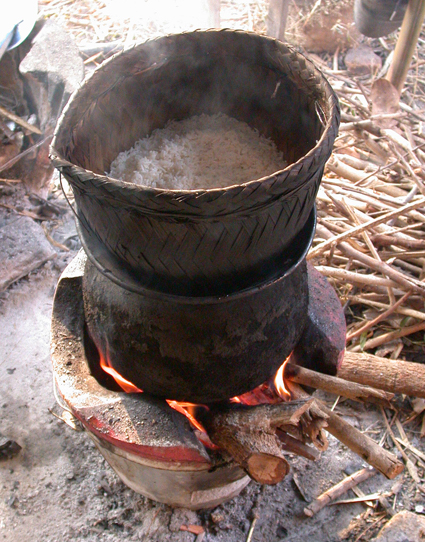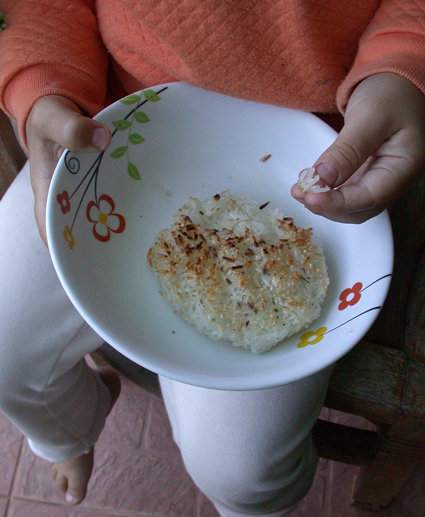Kao ping
Now when the Chiang Mai mornings are cold (13°C), a hot breakfast is highly appreciated by the Seehamongkol family, owners of Dokmai Garden. One simple hot food is ‘kao ping’, i.e. ‘grilled sticky rice’.
Sticky rice (glutinous rice, ‘kao niao’) is a staple food in Laos, northern Thailand and Esan (that is the northeast of Thailand, the home of the Seehamongkol family). That rice is the same species as any other rice, i.e. rice is the grains or seeds of a grass (Oryza sativa, Poaceae). Numerous times I have heard from farang (westerners) that sticky rice is rice boiled with sugar, making it sticky. That must be another dish, because there is no sugar added to traditional ‘kao niao’. Sticky rice has a starch composed of sticky amylopectin, while non-sticky rice varieties have a starch mainly composed of amylose. The reason rice grains (rice seeds) contain starch is to feed the young grass embryo until it can make leaves and its own carbohydrates. Humans simply rob and kill that embryo. The sticky rice variety is sometimes referred to as Oryza sativa var. glutinosa.
Sticky rice is a staple carbohydrate since 2000 years. It is traditionally eaten with your hands, and you dip it into various other dishes. Knives, forks, spoons and chopsticks are recent introductions to the northern Thai cuisine. Sticky rice is also used to make rice wine and ‘kao koa’, i.e. dry-fried sticky rice powder, an important ingredient in many local dishes.
To prepare the dry sticky rice grains you buy in bags, simply soak the rice in water for at least four hours. Ketsanee and Nived have a routine to soak the rice at 8 p.m. and then steam it at sunrise (06.30) the following morning. As mentioned before, this discarded water is used for pickling vegetables. Remember that Esan and northern Thailand are very dry monsoon areas, more similar to northern India than to Bangkok, so water is precious in the dry season.
The soaked sticky rice is transferred to a rice basket and put on a vessel (terracotta or aluminium) with water, which in turn is put on a fire. Steam penetrates the rice for about one hour after which the rice is ready to be eaten. It can be kept all day and is often consumed cold, and used in workers’ lunch boxes which in older times were bamboo sticks.
 Breakfast routine at Dokmai Garden.
Breakfast routine at Dokmai Garden.
 To make ‘kao ping’, grilled sticky rice, simply make a flattened cake of steamed sticky rice and grill it gently over open fire. Add some salt for flavour. Mika, soon five years old, finds this very delicious!
To make ‘kao ping’, grilled sticky rice, simply make a flattened cake of steamed sticky rice and grill it gently over open fire. Add some salt for flavour. Mika, soon five years old, finds this very delicious!
Text & Photo: Eric Danell



Hello Eric,
I’ll have to try that.
Nathalie and I tried making sticky rice with coconut and mango like Ketsanee’s mother made me. The Mangos said from Phillipines but on further inspection said “Product of Equador”.
Of course, is was fine but not as excellent as what I had at Dokmai Gardens.
From a cool -27C tonight!
David
Dear David,
Many thanks for the report! Minus 27 sounds exotic…
Cheers, Kate, Eric and Mika